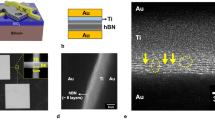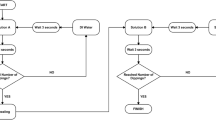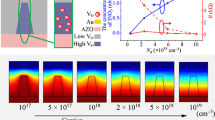Abstract
Memristors with nonlinear characteristics can replace passive devices to construct nonlinear and chaotic circuits, which gives new challenges and opportunities to traditional circuits. This paper presents a series of Cu-doped Cu/TiOx:Cu/Ti physical memristors with various TiO2 thicknesses by controlling the sputtering time, whose characteristics and mathematical models are explored based on the switching mechanism and v–i characteristics. To better characterize the effect of the physical memristor, a fifth-order memristive circuit is built based on it. With its dimensionless equations, complex coexisting behaviors of multiple kinds of attractors, including stable point attractors, limit cycles, and chaotic attractors, are numerically revealed. In addition, a hardware circuit with physical memristors is implemented, from which multiple coexisting attractors are conveniently captured, verifying the numerical simulations.


















Similar content being viewed by others
Data availability
All data included in this study are available upon request by contact with the corresponding author.
References
Chua, L.O.: Memristor-the missing circuit element. IEEE Trans. Circuit Theory 18, 507–519 (1971)
Strukov, D.B., Snider, G.S., Stewart, D.R., Williams, R.S.: The missing memristor found. Nature 453, 80–83 (2008)
Peng, Z.H., Wu, F.C., Jiang, L., et al.: HfO2-Based memristor as an artificial synapse for neuromorphic computing with Tri-Layer HfO2/BiFeO3/HfO2 design. Adv. Funct. Mater. 31, 2107131 (2021)
Ji, X., Qi, D., Dong, Z., et al.: TSSM: three-state switchable memristor model based on Ag/TiOx nanobelt/Ti configuration. Int. J. Bifurc. Chaos 31, 2130020 (2021)
Kim, I.S., Woo, J.U., Hwang, H.G., et al.: Artificial synaptic and self-rectifying properties of crystalline (Na1-xKx)NbO3 thin films grown on Sr2Nb3O10 nanosheet seed layers. J. Mater. Sci. Technol. 123, 136–143 (2022)
Gutsche, A., Siegel, S., Zhang, J.C., et al.: Exploring area-dependent Pr0.7Ca0.3MnO3-based memristive devices as synapses in spiking and artificial neural networks. Front. Neurosci. 15, 661261 (2021)
Zhou, E., Fang, L., Liu, R., et al.: Area-efficient memristor spiking neural networks and supervised learning method. Sci. China: Inf. Sci. 9, 3 (2019)
Wang, X.P., Wan, H.B., Chen, Q., Yang, R.: A logic circuit design for perfecting memristor-based material implication. IEEE Trans. Comput-Aided Des. Integr. Circuits Syst. 36, 279–284 (2017)
Jiang, F.H., Yuan, F., Li, Y.X.: Design and implementation of XOR logic circuit based on generalized memristor. Eur. Phys. J. Spec. Top. 231, 481–491 (2022)
Ali, K.A., Rizk, M., Baghdadi, A., et al.: Memristive computational memory using memristor overwrite logic (MOL). IEEE Trans. Very Large Scale Integr. 28, 2370–2382 (2020)
Wang, X.Y., Li, P., Ji, C.X., et al.: General modeling method of threshold-type multivalued memristor and its application in digital logic circuits. Int. J. Bifurc. Chaos 31, 2150248 (2021)
Liu, X.Y., Huang, Y., Zeng, Z.G., Wunsch, D.C.: Memristor-based HTM spatial pooler with on-device learning for pattern recognition. IEEE Trans. Syst. Man Cybern.-Syst. 52, 1901–1915 (2022)
Lin, P., Li, C., Wang, Z., et al.: Three-dimensional memristor circuits as complex neural networks. Nat. Electron. 3, 225–232 (2020)
Vijay, H.M., Ramakrishnan, V.N.: Radiation effects on memristor-based nonvolatile SRAM cells. J. Comput. Electron. 17, 279–287 (2018)
Lanza M, Sebastian A, Lu W D, et al.: Memristive technologies for data storage, computation, encryption, and radio-frequency communication. Science 376, eabj9979 (2022).
Di Marco, M., Forti, M., Pancioni, L., et al.: Memristor neural networks for linear and quadratic programming problems. IEEE Trans. Cybern. 52, 1822–1835 (2022)
Li, C., Belkin, D., Li, Y., et al.: Efficient and self-adaptive in-Situ learning in multilayer memristor neural networks. Nat. Commun. 9, 2385 (2018)
Faggini, M.: Chaos and chaotic dynamics in economics. Nonlinear Dyn. Psychol. Life Sci. 13, 327–340 (2009)
Kim, M.S.: Chaos theory: an alternative for a paradigm shift in the social science studies. J. Korea Acad.-Ind. Cooper. Soc. 15, 6621–6629 (2014)
Strogatz, S.H.: Nonlinear dynamics and chaos: with applications to physics, biology, chemistry, and engineering. Perseus Books, USA (1994)
Bru Villaseca, L.: The revolution of chaos. Chaos and biology. Anal. Real Acad. Nac. Med. 107, 339–351 (1990)
Grassi, G.: Chaos in the real world: recent applications to communications, computing, distributed sensing, robotic motion. Bio-impedance modelling and encryption systems. Symmetry 13, 2151 (2021)
Peng, Y.X., Sun, K.H., He, S.B.: Parameter identification for discrete memristive chaotic map using adaptive differential evolution algorithm. Nonlinear Dyn. 107, 1263–1275 (2022)
Itoh, M., Chua, L.O.: Memristor oscillators. Int. J. Bifurc. Chaos 18, 3183–3206 (2008)
Tan, Q.W., Zeng, Y.C., Li, Z.J.: A simple inductor-free memristive circuit with three line equilibria. Nonlinear Dyn. 94, 1585–1602 (2018)
Zhang, Y.Z., Liu, Z., Wu, H.G., et al.: Two-memristor-based chaotic system and its extreme multistability reconstitution via dimensionality reduction analysis. Chaos Solitons Fractals 127, 354–363 (2019)
Huang, L.L., Liu, S., Xiang, J.H., Wang, L.Y.: Design and multistability analysis of five-value memristor-based chaotic system with hidden attractors. Chin. Phys. B 30, 100506 (2021)
Lai, Q., Chen, Z.J.: Grid-scroll memristive chaotic system with application to image encryption. Chaos Solitons Fractals 170, 113341 (2023)
Lai, Q., Wan, Z.Q., Zhang, H., Chen, G.R.: Design and analysis of multiscroll memristive Hopfield neural network with adjustable memductance and application to image encryption. IEEE Trans. Neural Netw. Learn. Syst. (2022). https://doi.org/10.1109/TNNLS.2022.3146570
Sahin, M.E., Guler, H., Hamamci, S.E.: Design and realization of a hyperchaotic memristive system for communication system on FPGA. Traitem. Signal 37, 939–953 (2020)
Luo, J., Qu, S.C., Chen, Y., et al.: Synchronization, circuit and secure communication implementation of a memristor-based hyperchaotic system using single input controller. Chin. J. Phys. 71, 403–417 (2021)
Ma, M.L., Fang, Y.J., Li, Z.J., et al.: Bursting oscillations and bifurcation mechanism in a fully integrated piecewise-smooth chaotic system. Eur. Phys. J.-Spec. Top. 230, 1737–1749 (2021)
Wen, Z.H., Li, Z.J., Li, X.: Bursting oscillations and bifurcation mechanism in memristor-based Shimizu–Morioka system with two time scales. Chaos Solitons Fractals 128, 58–70 (2019)
Zhang, S., Li, C.B., Zheng, J.H., et al.: Generating any number of diversified hidden attractors via memristor coupling. IEEE Trans. Circuits Syst. I-Regul. Pap. 68, 4945–4956 (2021)
Sun, J.W., Zhao, X.T., Fang, J., Wang, Y.F.: Autonomous memristor chaotic systems of infinite chaotic attractors and circuitry realization. Nonlinear Dyn. 94, 2879–2887 (2018)
Sen, Z., Li, C.B., Zheng, J.H., et al.: Generating any number of initial offset-boosted coexisting Chua’s double-scroll attractors via piecewise-nonlinear memristor. IEEE Trans. Electron Devices 69, 7202–7212 (2022)
Batas, D., Fiedler, H.: A memristor SPICE implementation and a new approach for magnetic flux-controlled memristor modeling. Nanotechnol. IEEE Trans. Nanotechnol. 10, 250–255 (2011)
Abraham, I., Ren, S.Y., Siferd, R.E.: Logistic function based memristor model with circuit application. IEEE Access 7, 166451–166462 (2019)
Liang, Y., Wang, G., Chen, G., et al.: S-type locally active memristor-based periodic and chaotic oscillators. IEEE Trans. Circuits Syst. I Regul. Pap. 67, 5139–5152 (2020)
Bao, H., Wang, N., Wu, H.G., et al.: Bi-stability in an improved memristor-based third-order Wien–Bridge oscillator. IETE Tech. Rev. 36, 109–116 (2019)
Kumar, S., Strachan, J.P., Williams, R.S.: Chaotic dynamics in nanoscale NbO2 Mott memristors for analogue computing. Nature 548, 318–321 (2017)
Volos, C.K., Pham, V.T., Nistazakis, H.E., Stouboulos, I.N.: A dream that has come true chaos from a nonlinear circuit with a real memristor. Int. J. Bifurc. Chaos 30, 2030036 (2020)
Minati, L., Gambuzza, L.V., Thio, W.J., Sprott, J.C., Frasca, M.: A chaotic circuit based on a physical memristor. Chaos Solitons Fractals 138, 109990 (2020)
Sera, K., Lim, M.J., Chung, K.B.: Multi-level characteristics of TiOx transparent non-volatile resistive switching device by embedding SiO2 nanoparticles. Sci. Rep. 11, 9883 (2021)
Yang, J.J., Pickett, M.D., Li, X.M., et al.: Memristive switching mechanism for metal/oxide/metal nanodevices. Nat. Nanotechnol. 3, 429–433 (2008)
Acknowledgements
We acknowledge the help of the college of mechanical and electronic engineering, Shandong University of Science and Technology.
Funding
This work was supported by National Natural Science Foundation of China (Grant Nos. 62371274 and 61973200), Natural Science Foundation of Shandong Province (Grant No. ZR2023MF004), and Qingdao Natural Science Foundation (Grant No. 23-2-1-151-zyyd-jch). This work was also supported by the Elite Project of Shandong University of Science and Technology.
Author information
Authors and Affiliations
Corresponding author
Ethics declarations
Conflict of interest
The authors declare that they have no conflict of interest.
Additional information
Publisher's Note
Springer Nature remains neutral with regard to jurisdictional claims in published maps and institutional affiliations.
Rights and permissions
Springer Nature or its licensor (e.g. a society or other partner) holds exclusive rights to this article under a publishing agreement with the author(s) or other rightsholder(s); author self-archiving of the accepted manuscript version of this article is solely governed by the terms of such publishing agreement and applicable law.
About this article
Cite this article
Deng, Y., Li, S., Zhang, P. et al. Exploring thickness-dependent Cu/TiOx:Cu/Ti memristor and chaotic dynamics in a real fifth-order memristive circuit. Nonlinear Dyn 112, 1377–1394 (2024). https://doi.org/10.1007/s11071-023-09032-2
Received:
Accepted:
Published:
Issue Date:
DOI: https://doi.org/10.1007/s11071-023-09032-2




